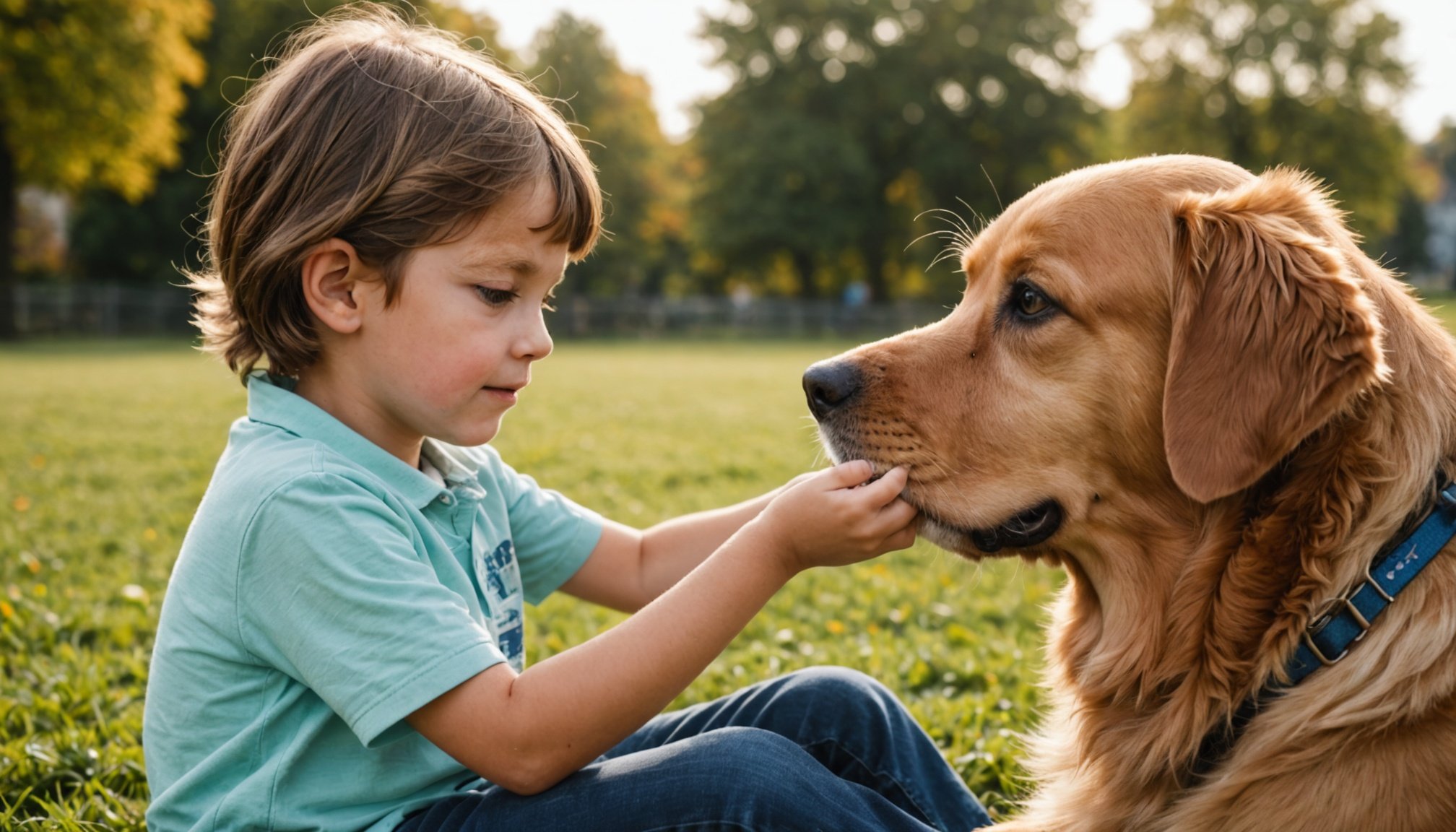Unlocking Social Skills: The Role of Pet-Assisted Therapy in Supporting Children with Autism
Understanding Autism and the Need for Social Skills Development
Autism, or Autism Spectrum Disorder (ASD), is a complex neurodevelopmental disorder characterized by challenges in social interaction, communication, and repetitive behaviors. Children with autism often face significant hurdles in developing social skills, which are crucial for their emotional and psychological well-being[3].
Social skills are essential for building relationships, communicating effectively, and navigating various social situations. However, individuals with autism may struggle with these skills due to difficulties in understanding social cues, initiating or maintaining conversations, and developing emotional connections with others.
Also to see : Transform Your Flexibility and Wellness: The Benefits of Aerial Yoga Explained
The Concept of Animal-Assisted Therapy
Animal-Assisted Therapy (AAT) has emerged as a powerful tool in supporting the development of social skills in children with autism. This therapy involves the use of animals, typically dogs, but also other animals like horses, cats, and even dolphins, to facilitate therapeutic goals.
AAT is defined by its focus on using the presence and interaction with animals to achieve specific therapeutic outcomes. For children with autism, this can include improving social skills, enhancing emotional support, and reducing anxiety and stress[4].
In parallel : Maximizing Your Health: Top Strategies for Effective Fitness Tracker Use in Personal Wellness Monitoring
How Animal-Assisted Therapy Works
Building Emotional Connections
One of the primary ways AAT helps children with autism is by providing an emotional connection that can be challenging to establish with humans. Animals, particularly dogs, offer unconditional love and acceptance, which can be incredibly comforting for children who may feel judged or misunderstood.
As François Dupuy, an infirmier at the Henri-Laborit hospital, notes, “A horse, for example, does not seek to please humans. This makes it an ideal partner, becoming a true mirror of our emotions.”[2]
Enhancing Social Interactions
AAT sessions are designed to encourage social interactions between the child and the animal, as well as between the child and the therapist or other participants. Here are some ways AAT enhances social skills:
- Initiating and Maintaining Conversations: Interacting with animals can prompt children to talk about their experiences, feelings, and observations, helping them develop conversational skills.
- Understanding Social Cues: Animals can help children understand and respond to social cues, such as body language and vocal tones.
- Building Trust and Confidence: The trust and confidence built through interactions with animals can translate to human relationships, making it easier for children to engage in social interactions.
Sensory Integration and Motor Skills
Children with autism often have sensory integration issues and may benefit from the tactile and sensory experiences provided by interacting with animals. Here are some examples:
- Tactile Experiences: Petting, grooming, or simply touching animals can provide a calming and organizing sensory input.
- Motor Skills Development: Activities such as walking a dog, feeding animals, or participating in equine therapy can help improve motor skills and coordination[1].
Benefits of Animal-Assisted Therapy for Children with Autism
Emotional Support
AAT offers significant emotional support to children with autism. Here are some key benefits:
- Reduced Anxiety and Stress: Interacting with animals has been shown to reduce anxiety and stress levels in children with autism.
- Improved Mood: The emotional connection with animals can improve mood and overall well-being.
- Increased Self-Esteem: The positive interactions and feedback from animals can enhance self-esteem and confidence.
Social Skills Development
AAT is particularly effective in developing social skills:
- Improved Communication: Children are encouraged to communicate with the animal and the therapist, enhancing their verbal and non-verbal communication skills.
- Enhanced Social Interactions: AAT promotes social interactions, helping children to understand and respond to social cues better.
- Better Relationships: The skills learned through AAT can help children build better relationships with their peers and family members.
Sensory and Motor Benefits
- Sensory Integration: Interacting with animals can help integrate sensory inputs, reducing sensory overload and improving sensory processing.
- Motor Skills: Activities involving animals can improve fine and gross motor skills, balance, and coordination.
Case Studies and Examples
Equine Therapy
Equine therapy, which involves horses, is a specialized form of AAT that has shown remarkable results. For instance, a study at the Henri-Laborit hospital in Poitiers found that patients with psychiatric disorders, including those with autism, made significant progress in their social and emotional development through equine therapy.
As Samantha Gadret, the director of the establishment, noted, “He has made enormous progress in contact with the riders he works with, in terms of speech and relationships.”[2]
Canine Therapy
Canine therapy, involving dogs, is another widely used form of AAT. For example, the “4 Pattes Tendresse Ile-de-France” program uses trained dogs to support individuals with various disabilities, including autism. The program focuses on activities such as walking, agility courses, and sensory games to enhance social, cognitive, and motor skills[4].
Practical Insights and Actionable Advice
For parents or caregivers considering AAT for a child with autism, here are some practical insights and actionable advice:
Finding the Right Program
- Research Local Programs: Look for certified AAT programs in your area that specialize in working with children with autism.
- Consult with Professionals: Discuss the potential benefits and any concerns with your child’s therapist or healthcare provider.
Preparing Your Child
- Gradual Introduction: Introduce your child to the animal gradually to avoid any initial anxiety or fear.
- Positive Reinforcement: Encourage positive interactions by rewarding your child with praise or small treats when they engage appropriately with the animal.
Involving the Family
- Family Participation: Involve other family members in the AAT sessions to enhance the social benefits and create a supportive environment.
- Consistency: Ensure that the skills learned during AAT sessions are reinforced at home through consistent practices and activities.
Comparison of AAT with Other Therapies
Here is a comparison of AAT with other commonly used therapies for children with autism:
| Therapy Type | Focus | Benefits | Examples of Activities |
|---|---|---|---|
| Animal-Assisted Therapy (AAT) | Emotional support, social skills, sensory integration | Reduced anxiety, improved mood, enhanced social interactions | Petting dogs, grooming horses, feeding animals |
| Applied Behavior Analysis (ABA) Therapy | Behavioral modification, skill acquisition | Improved behavior, increased skill acquisition, reduced problem behaviors | Discrete trial training, reinforcement schedules |
| Occupational Therapy (OT) | Sensory integration, motor skills | Improved sensory processing, enhanced motor skills, better daily functioning | Sensory integration activities, motor skills exercises |
| Speech Therapy | Communication skills | Improved verbal and non-verbal communication | Articulation exercises, conversation skills training |
Animal-Assisted Therapy is a powerful and compassionate approach to supporting children with autism in their social skills development. By leveraging the unique bond between humans and animals, AAT offers a range of benefits that can enhance emotional support, social interactions, and sensory integration.
As we continue to discover the full potential of AAT, it is clear that this therapy can be a valuable addition to the treatment plans of children with autism. Whether through the gentle giant of a horse or the loving companionship of a dog, animals are helping children unlock their social skills and live more fulfilling lives.
In the words of Anne Héron, director of the Pégase study, “It is not a panacea, nor a magic remedy, but it is an additional tool in the therapist’s palette and a possible path to healing for certain patients.”[2]
By embracing AAT and other forms of therapy, we can provide children with autism the support and tools they need to thrive in a world that is often challenging but always full of potential.
Empirical Evidence Supporting Pet-Assisted Therapy
The growing interest in pet-assisted therapy has led to numerous research findings and case studies. These studies draw from expert opinions and highlight the tangible benefits of integrating animals into therapeutic settings.
Overview of Key Studies
Research findings indicate that pet-assisted therapy can significantly enhance emotional well-being. One study from the Journal of Clinical Psychology reported that participants in sessions involving animals showed a notable decrease in anxiety symptoms, compared to traditional methods alone. Such studies are pivotal for understanding the scope of therapeutic benefits animals can offer.
Notable Testimonials from Practitioners
Behavior therapists and psychologists have shared glowing testimonials, emphasizing the profound impact of pet-assisted therapy. Experts, including Dr. Jane Thompson, have observed that sessions with therapy animals often result in increased relaxation and a higher sense of comfort among patients. These expert opinions not only support existing research findings but also underscore the practical implications in a clinical setting.
Personal Stories from Families
Families have shared heartwarming personal stories, depicting transformative impacts on children’s lives. For example, one family’s experience, where a child with autism significantly improved communication skills through regular sessions with a therapy dog, illustrates the practical application of pet-assisted therapy. Such testimonials provide evidence of the effectiveness of incorporating animals into therapeutic practices.
Practical Tips for Implementing Pet-Assisted Therapy
Implementing pet-assisted therapy requires careful consideration to ensure effectiveness and safety. Finding qualified pet therapy programs is essential; look for certified professionals who are experienced in working with animals specifically trained for therapeutic settings. These professionals can guide you through the program’s implementation process and offer insights tailored to your needs.
Safety Considerations
Safety is paramount when integrating animals into therapeutic environments. Select animals that have undergone rigorous training and evaluation. It is crucial to ensure that their temperament and behaviour align with the goals of therapy. Certified therapy animals typically include species like dogs, cats, and even horses. Each has its unique benefits depending on the therapeutic objectives.
Parental Guidance
Parents play a pivotal role in the success of pet-assisted therapy, especially in home settings. They should seek resources that provide strategies on engaging children with therapy animals. Simple activities, such as routine pet care or nature walks with a therapy dog, can promote a sense of responsibility and emotional connection. Parents must ensure the home environment is conducive for both the animal’s and child’s well-being. Selecting the right resources and guidance from experienced professionals can be instrumental in creating a harmonious and therapeutic experience.
Resources for Parents and Caregivers
Navigating the path to effective caregiving often requires a reliable network of resources and support. Parents and caregivers can benefit immensely from a variety of support groups and educational materials. Understanding how to integrate therapeutic elements into daily life can reduce stress and improve outcomes.
Community Support and Online Groups
Finding a community that shares similar experiences can significantly enhance the caregiving journey. Community-based support groups, both local and online, serve as invaluable forums for sharing advice, support, and personal stories. They allow for emotional expression and provide practical solutions. Online platforms can connect you with experts and fellow caregivers worldwide, offering immediate advice and camaraderie without geographical boundaries.
Recommended Books and Articles
Educational materials are critical for expanding one’s knowledge. Delve into recommended books and articles that cover a range of topics, from emotional coping strategies to practical caregiving tips. These materials often provide insights from professionals and other caregivers, offering strategies and techniques that can be applied in real-world scenarios.
Workshops and Training Opportunities
Workshops and training sessions offer hands-on experience and specialized knowledge in a structured environment. These opportunities can focus on areas such as therapy animal training and fostering integration into home life. Participating in such events can arm caregivers with the skills needed to tailor support strategies effectively while promoting personal growth and resilience.
Understanding Pet-Assisted Therapy
Pet-assisted therapy, an integrative branch of alternative therapy, leverages human-animal interactions to enhance emotional, physical, and social well-being. It is designed to promote comfort and healing in diverse therapeutic contexts. Pet-assisted therapy aims not only to aid in emotional and psychological recovery but also in physical rehabilitation, often within hospitals, schools, or nursing homes.
Types of Therapy Animals
A variety of animals can serve as therapy companions, each offering unique benefits. Dogs, for example, are frequently employed due to their sociable nature and adaptability in various environments. Cats, with their calming presence, are also popular, especially in settings where a less active animal is preferable. Horses, through programs like equine-assisted therapy, offer opportunities for physical activity and emotional growth. Even smaller pets like rabbits or guinea pigs are effective in fostering a sense of tranquility. Every type of therapy animal has its niche, allowing for tailored support depending on the needs of the individuals involved.
Historically, the concept of pet-assisted therapy emerged in the late 18th century, with formal practices developing significantly over the past few decades. This evolution highlights a growing recognition of the therapeutic potential of animal companionship. The ongoing exploration of pet-assisted therapy continues to expand its reach and refine its methodologies.
Benefits of Pet-Assisted Therapy for Children with Autism
Pet-assisted therapy offers substantial benefits for children with autism, significantly enhancing their lives. It often involves animals, such as dogs or horses, that help individuals build social skills and emotional support. Children with autism frequently experience challenges with emotional regulation and often have heightened levels of anxiety. Engaging with therapy animals can help in reducing anxiety and encouraging a greater sense of calm and well-being.
Moreover, animals act as nonjudgmental companions who promote social interactions. They serve as a bridge, facilitating the development of effective communication skills and fostering greater confidence in social settings. Interactions involving grooming, playing, or walking pets can greatly enhance a child’s social skills by providing practical scenarios where they can practice communication and interaction.
Alongside these practical benefits, pet-assisted therapy fosters a sense of companionship and unconditional support. This type of therapy often creates an emotional connection between the child and the pet, which can lead to a more supportive and enriching environment. These companionship bonds are instrumental in making children feel less isolated, providing them with a unique friend who offers resilience, understanding, and comfort.
Overall, pet-assisted therapy powerfully encourages emotional growth, making it a viable option for aiding children with autism in navigating social and emotional challenges.
Research Evidence on Pet-Assisted Therapy and Autism
Recent research findings have highlighted the potential benefits of pet-assisted therapy in enhancing social skills among individuals with autism. Studies have shown that interacting with animals can significantly increase engagement and communication abilities. This is largely because animals provide a non-judgmental presence that encourages individuals to express themselves more freely.
Case Studies Highlighting Success
Various case studies provide compelling evidence of the effectiveness of pet-assisted therapy. For instance, a case involving a young boy on the autism spectrum revealed notable improvement in eye contact and verbal communication after regular sessions with a therapy dog. Another study documented how interactions with guinea pigs in a classroom setting improved children’s patience and sharing abilities.
Expert Opinions and Testimonials
Expert opinions further reinforce the positive impact of pet-assisted therapy. Many therapists emphasize the calming and motivational effects that animals have on children with autism. Testimonials from parents also attest to marked improvements in their children’s social interactions and overall behaviour when incorporating animals into therapy sessions.
The convergence of research findings, case studies, and expert insights underscores the practical and transformative potential of pet-assisted therapy as an evidence-based practice for supporting individuals with autism. This approach continues to gain traction as more families and therapists observe its inclusive and empowering benefits.
Practical Applications of Pet-Assisted Therapy
Implementing pet-assisted therapy into clinical settings requires careful planning and understanding. It begins with establishing clear guidelines that ensure the safety and well-being of both patients and animals. This includes setting up appropriate environments, ensuring cleanliness, and providing proper training for handlers.
Selecting Appropriate Therapy Animals
Choosing the right animals is crucial for successful implementation. Not all pets are suitable for therapeutic roles. Animals should be evaluated for temperament, health, and sociability. Dogs and cats are common, but other species like rabbits and horses also offer therapeutic benefits. Specialised training programs can aid in bettering animal and human interactions.
Structuring Therapy Sessions
Effective therapy sessions are meticulously structured to maximise benefits for all participants. Sessions should be tailored to individual client needs, with defined goals and outcomes. Consideration must be given to the animal’s comfort and stress levels to maintain a positive environment.
Practical Tips:
- Ensure animals are regularly checked by vets.
- Develop a session plan to guide therapy.
- Have contingency plans for unexpected situations.
By focusing on these practices, pet-assisted therapy can be facilitated smoothly, offering a seamless and enriching experience for both therapists and clients. This approach flawlessly merges therapeutic strategies with animal companionship, enhancing the healing process.
Challenges and Considerations in Pet-Assisted Therapy
Pet-assisted therapy offers numerous benefits but presents distinct challenges and considerations. Implementation challenges arise from ensuring the therapy environment supports both the child and animal’s well-being. For instance, facilities must be equipped to handle the safety of children, with accessible and monitored areas to prevent accidents. Particular attention to health considerations is essential, as animals must be regularly vaccinated and groomed to prevent the transmission of diseases.
Additional safety practices include training animals to interact gently with children. This effort extends to handlers being certified to interpret animal behavior and stepping in when necessary to ensure the safety of all participants.
Another critical factor is the ethical considerations in pet-assisted therapy. Therapy providers must assess the responsibilities involved, including the ethical treatment and welfare of animals involved. The well-being of the animals should never be compromised for the sake of therapy. This means considering their workload, stress levels, and the suitability of certain therapy types for different animal species.
Responsible providers implement regular evaluations of both staff conducting sessions and participants to align with ethical standards. These evaluations are paramount in maintaining a balanced, supportive environment where therapy can proceed without unnecessary challenges.











